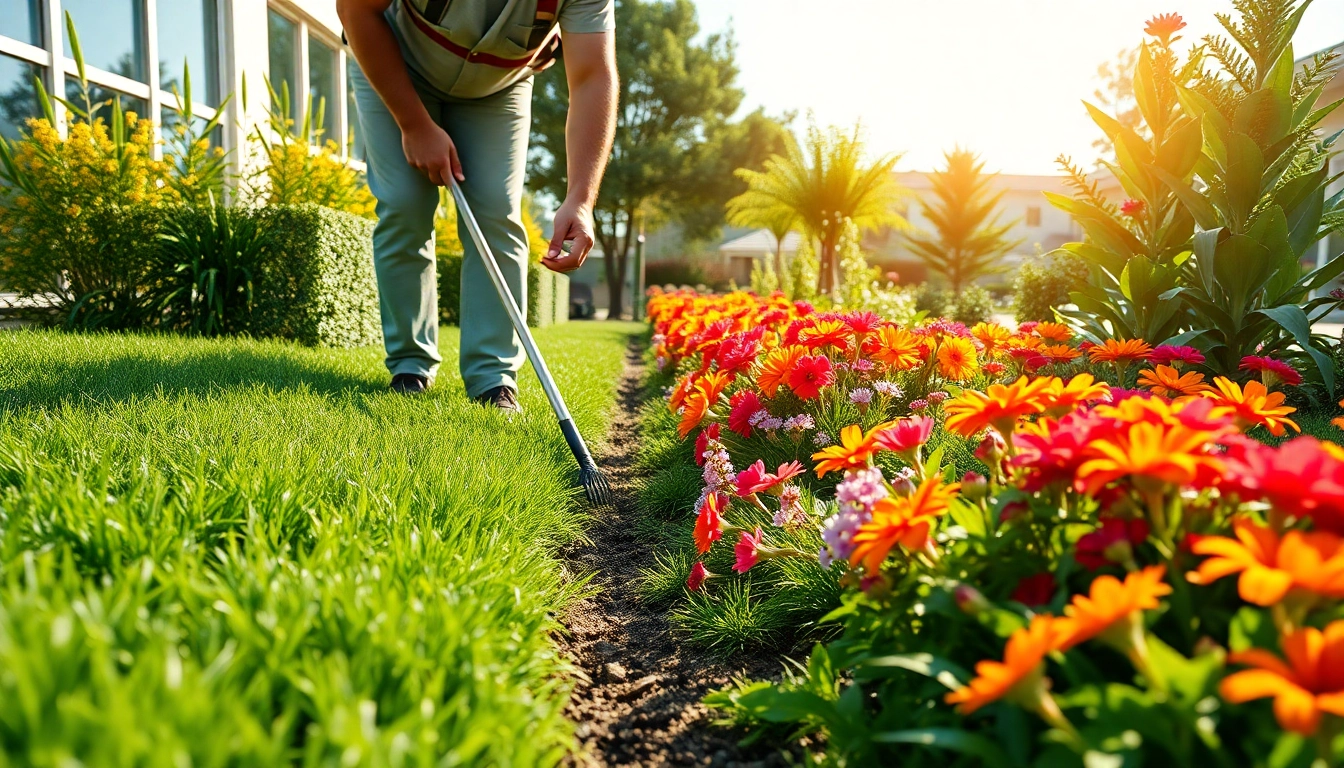Understanding the Role of Commercial Landscaping Contractors
When it comes to maintaining the visual appeal and functionality of commercial spaces, commercial landscaping contractors play a pivotal role. These professionals are responsible for transforming outdoor areas into inviting, well-organized landscapes that not only enhance a property’s aesthetics but also contribute to its overall value and appeal. This comprehensive guide explores the various aspects of commercial landscaping, detailing what these contractors do, the benefits they bring, and the services they offer.
What Commercial Landscaping Contractors Do
Commercial landscaping contractors specialize in designing, implementing, and maintaining outdoor spaces for businesses, parks, and municipalities. Their work extends beyond mere plant installation to include several critical tasks:
- Designing Landscapes: These professionals assess the space and create designs that consider aesthetic appeal, functionality, and ecological sustainability.
- Implementing Features: This involves selecting plants, trees, and shrubs, as well as incorporating hardscape elements like patios, walkways, and retaining walls.
- Maintenance: Regular upkeep is essential to preserve the health and attractiveness of the landscape, which includes mowing, pruning, fertilizing, and pest management.
- Irrigation Systems: Expert contractors install and maintain irrigation systems to ensure that water needs are met efficiently throughout the landscape.
Benefits of Hiring Professionals
Engaging commercial landscaping contractors brings several advantages to businesses, including:
- Expertise: These contractors are trained and experienced in horticulture and landscape design, ensuring the best outcomes for your outdoor space.
- Time-Saving: Outsourcing landscaping allows business owners to focus on their core operations while experts handle the intricacies of landscaping.
- Cost-Effectiveness: Proper planning and execution can prevent expensive mistakes and ensure that resources are used efficiently.
- Increased Property Value: Well-maintained landscapes can significantly enhance curb appeal, attracting more customers and increasing property value.
Types of Services Offered
Commercial landscaping contractors offer a diverse range of services tailored to meet the needs of various commercial properties.
- Landscape Design and Installation: From conceptualization to planting, contractors help create landscapes that reflect a business’s identity.
- Seasonal Clean-Up: This includes the removal of debris, fallen leaves, and conditions that affect the overall aesthetic during seasonal transitions.
- Lawn Care: Regular mowing, aeration, and fertilization contribute to a healthy lawn that sets the foundation for a beautiful landscape.
- Pest and Disease Management: Expert contractors can identify potential issues before they become severe, employing eco-friendly solutions when possible.
Choosing the Right Commercial Landscaping Contractor
Selecting the right contractor for your commercial landscaping needs is crucial to ensure successful outcomes. Here are essential considerations and steps to guide your decision-making process.
Key Factors to Consider
When evaluating potential contractors, consider the following keyFactors:
- Experience and Credentials: Look for contractors with a proven track record of similar projects and professional certifications.
- Portfolio: Reviewing previous work can provide insights into the contractor’s style and ability to meet client needs.
- Client Reviews and References: Testimonials and case studies from previous clients can offer valuable perspectives on a contractor’s reliability and work quality.
- Insurance and Licensing: Ensure that the contractor has necessary insurance and licenses to protect you from potential liabilities.
Questions to Ask Potential Contractors
Before making a final decision, ask potential contractors questions that will help clarify their capabilities and approach:
- What is your design process, and how do you incorporate client feedback?
- Can you provide a detailed estimate and breakdown of costs?
- How do you handle project timelines and potential delays?
- What maintenance services do you offer after the installation?
Evaluating Pricing and Value
Cost is often a deciding factor in choosing a contractor, but be cautious of selecting the lowest bid without considering value:
- Comprehensive Estimates: Ensure that estimates include all possible costs, including labor, materials, and ongoing maintenance.
- Value Over Price: Focus on the quality of materials and workmanship rather than merely the price tag.
- Long-Term Investment: Consider how professional landscaping can enhance business success in the long run, outweighing initial costs.
Popular Landscaping Designs for Commercial Spaces
Commercial spaces require unique landscaping designs that cater to functionality and aesthetic appeal. Below are some popular landscaping trends and styles.
Eco-Friendly Landscaping Trends
With growing concerns about sustainability, eco-friendly landscaping has gained traction. Techniques include:
- Native Plant Usage: Using native plants that require less water and maintenance contributes to sustainability.
- Rain Gardens: These features capture and filter rainwater, reducing runoff and promoting water conservation.
- Permeable Paving: Reduces stormwater runoff and encourages groundwater recharge by allowing rain to soak through.
Water Features and Hardscaping
Incorporating water features and hardscaping can significantly enhance the visual impact of commercial landscapes:
- Water Fountains: These add tranquility and elegance to commercial spaces while promoting relaxation.
- Patios and Walkways: Hardscaping elements provide functional spaces for gatherings and events, enhancing customer experience.
- Seating Areas: Well-placed seating encourages visitors to linger, promoting interaction and enjoyment of the landscape.
Seasonal Planting Strategies
Effective landscaping considers seasonal changes through smart planting strategies that ensure year-round appeal:
- Spring Blooms: Select flowering plants that provide vibrant colors to attract attention as they bloom in spring.
- Fall Foliage: Planting trees and shrubs with changing colors can create stunning displays as the seasons change.
- Winter Interest: Incorporate evergreens and structural plants that maintain visual interest during winter months.
Managing Your Landscaping Project Effectively
Effective management of your landscaping project is crucial to ensuring that it meets expectations and stays within budget. Here are strategies to help you through the process:
Setting Clear Goals and Expectations
Before the project begins, it’s essential to establish clear goals:
- Define Your Vision: Clearly articulate what you envision to the contractor, including style, features, and functionality.
- Budgeting: Set a realistic budget that encompasses all aspects of the project, including unexpected costs.
- Timeline: Create a timeline that outlines project phases, from design to completion, ensuring all parties are aligned.
Communication Best Practices
Ongoing communication is vital for project success. Consider the following practices:
- Regular Updates: Request consistent updates from the contractor regarding progress and any arising issues.
- Feedback Loops: Establish a process for providing feedback throughout the project to ensure alignment with your vision.
- Open Dialogue: Encourage transparency and open discussion about challenges or changes that may need to be addressed.
Tracking Progress and Performance
Monitoring the project’s progress is essential for staying on schedule and within budget:
- Milestone Check-Ins: Schedule periodic check-ins to review work completed against planned milestones.
- Quality Control: Assess the quality of work and materials used, ensuring they match standards agreed upon initially.
- Budget Tracking: Regularly reconcile project costs against the budget, addressing any discrepancies quickly.
Measuring the Impact of Landscaping on Business Success
Commercial landscaping can have a significant impact on the success of a business. Understanding this influence can help justify the investment in professional landscaping services.
How Aesthetic Enhancements Attract Customers
Research indicates that the appearance of a business’s outdoor space plays a critical role in attracting customers:
- First Impressions: A well-maintained landscape creates a positive first impression, setting the tone for customer experience.
- Brand Image: Aesthetic choices reflect a brand’s identity, resonating with the target customer demographic.
- Foot Traffic: Visually appealing landscapes can increase foot traffic, ultimately leading to higher sales.
Boosting Property Value through Professional Landscaping
Investing in professional landscaping can increase property value significantly:
- Appraisal Increases: Professional landscapes are often viewed as an asset in property appraisals, contributing to higher market values.
- Long-Term Investment: A beautiful and functional landscape can remain a valuable asset for years, providing returns well beyond initial installation costs.
- Competitive Advantage: Properties with superior landscaping often stand out in competitive markets, attracting more tenants or buyers.
Case Studies: Success Stories from Top Commercial Clients
Examining real-world examples can illustrate the substantial benefits derived from strategic landscaping:
- Retail Chains: A national retail chain reported a 20% increase in sales at stores with professionally landscaped exteriors compared to those without.
- Corporate Headquarters: A prominent tech firm saw employee satisfaction and productivity improve after landscape renovations, attributed to enhanced outdoor workspaces.
- Restaurants: Full-service restaurants that implemented outdoor dining areas with well-designed landscaping experienced a 30% increase in seating capacity utilization.



